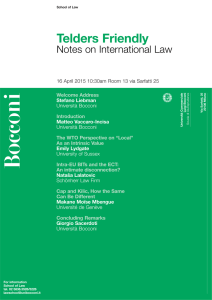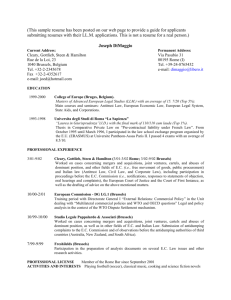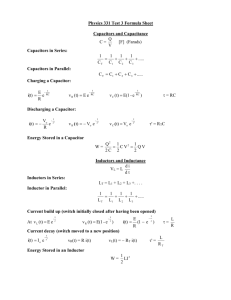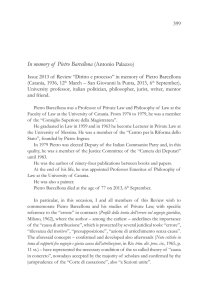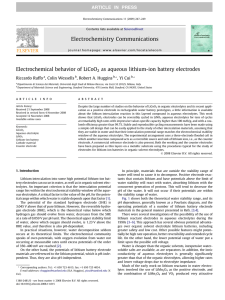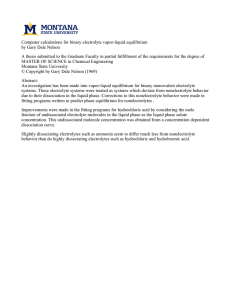A Strong electrolytes
advertisement
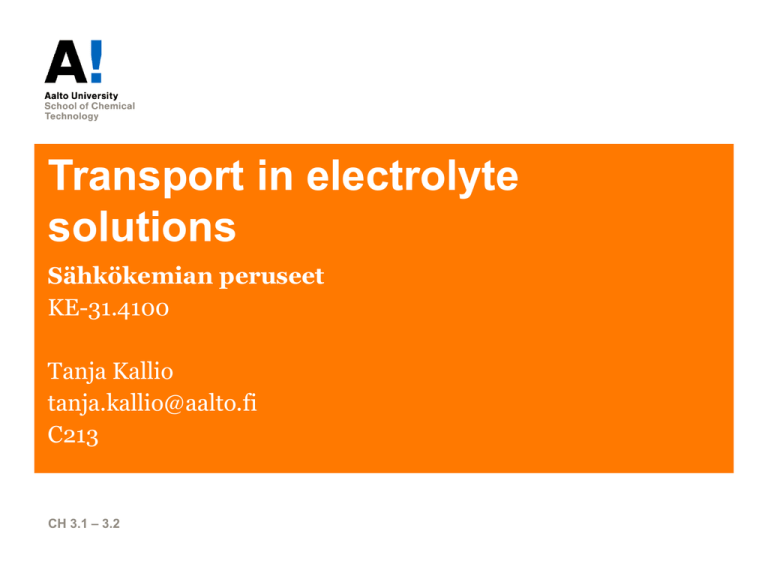
Transport in electrolyte solutions Sähkökemian peruseet KE-31.4100 Tanja Kallio tanja.kallio@aalto.fi C213 CH 3.1 – 3.2 Ion distribution in the bulk and near the surface Spatial distribution of ions obeys Boltzmann distribution ci (r ) cib e zi ( r ) J. Israelachivili, Intermolecular and surface forces Transport and reactions electrode electrolyte i) mass transfer Cu2+ + e Cu+ ii) adsorption r i J Cu 2 F x 0 J Cu r kred cCus 2 kox cCus e- r = reaction rate Ji = flux of i iii) (electo)chemical reaction iv) desorption v) mass transfer x 0 Transport and mobility charged particle in an electric field (Fc) Fc Ff v Ff q Einstein Fc qE zeE f v kT zeE v D f mobility v uE u Ff = friction force q = charge of the particle E = electric field v = velocity D = diffusion coefficient u = mobility zFD RT v zeD zFD E E kT RT kT D Mobility, molar conductivity and diffusion coefficient Ohm’s law adapted Faraday’s law i F zk J k F zk vk ck i E k k ck k k from previous slide F2 i RT F 2 z k2 Dk k z Dk ck E k RT & k zk uk F 2 k Stokes’ law can be applied to determine friction coefficeint for ions f 6a D kT 6a = viscosity a = ion radius am idi DM SO HC OO H n-p rop ano li NM F et a nol i ves i DM F me tan oli TH F DM OE AC N ase t on i for m Walden rule D 0.7 0.6 kT 6a D constant 0.8 K+(●) Cs+ (■) 0.5 0.4 0.3 0.2 0.1 Measuring conductivity F2 RT zk2 Dk ck & D k k ck k johtokykymittari Rs 1 l A • Exchange current • Pt-electrodes • calibration kT 6a Electronic vs. ionic conductivity Electronic conductivity: current is transported by electrons i) conductors ii) semi conductors iii) insulators Ionic conductivity: current is transported by ions i) strong electrolytes ii) weak electrolytes iii) non electrolytes Material Cond / S cm-1 Ag 1.59×105 Cu 1.68×105 Au 2.44×105 Pt 1.06×104 C (amorphous) 5-8×101 C (graphite)* 2.5-5.0×103 / 3.0×101 Ge 4.6×10−2 Si 10-1 - 10-5 Water 10-9 Glass 10-16 - 10-12 PTFE (Teflon®) 10-16 -10-12 http://wiki.answers.com/Q/Wh ich_metals_are_the_most_co nductive#ixzz25OZd6XAR Structure, mobility i Proton transport via Grothus or hopping mechanism ii iii Strong electrolytes - Kohlrausch’s law (1/2) Dependency of diffusion coefficient on concentration ln i Di Di, 1 ln c i Debye-Hückel limiting law for 1:1 electrolytes I log z z A I A c 1 zi2 ci 2 i c Using above diffusion coefficient can be written as ln i ln i 1 c B c ln c c 2 2.303 Di Di , 1 A c 2 B = 2.303 A Strong electrolytes - Kohlrausch’s law (2/2) F 2 z k2 Dk k RT 2,303 Di Di , 1 A c 2 K c Kohlrausch’s law Weak electrolytes – Ostwald dilution law (1/2) (1 - )c c c A B A B Kd A cA B cB c AB c 1 1 is small ± ~ 1. So for 1:1 electrolytes 2c Kd 1 Weak electrolytes – Ostwald dilution law (2/2) c+ and c- are low + ~ +, and - ~ -, c c , , c Combining this with rearranged equation for equilibrium constant for 1:1 electrolytes 1 c 1 Kd 1 1 c K d 2 Ostwald dilution law Comparison of a weak and a strong electrolyte KCl http://chemguide.blogspot.fi/2010/04/vari ation-of-conductivitywith.html Electrolyte dissociation in an organic solvent Dissociation is incomplete → Ostwald dilution law Because of interactions ± must be included For 1:1 electrolytes A cA BcB Kd cAB 2 2 c 1 K d 1 4 2 c / K d 1 2 2 c It has been noted experimentally that K c tetrabutyyliammoniumtetrakis (4-klorofenyyli)borate in 1,2diklooriethane

